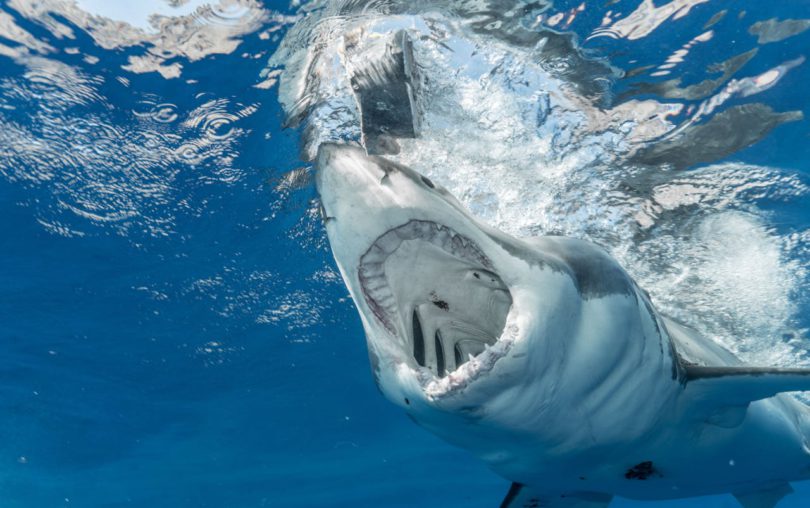Sharks are often portrayed as fearsome predators of the deep, but their true power lies not just in sharp teeth and speed—it’s in their extraordinary senses. Among the most impressive of these is their sense of smell. Sharks can detect tiny amounts of blood in water from incredible distances, a superpower that has fascinated scientists, divers, and ocean enthusiasts for centuries. But how exactly do sharks achieve this, and why is their sense of smell so finely tuned?
The Anatomy of a Shark’s Nose
Unlike humans, sharks don’t use their mouths for smelling—they have specialized nostrils called nares, located on the underside of their snouts. Water flows into these nares as the shark swims, allowing olfactory receptors inside to detect chemicals dissolved in the water. Each nare functions independently, giving sharks the ability to “sample” water in multiple directions, much like a dog sniffing the air.
The olfactory bulbs in a shark’s brain are disproportionately large, reflecting the importance of smell in their daily lives. This powerful combination of structure and sensitivity allows sharks to detect blood concentrations as low as one part per ten billion—essentially a few drops in an Olympic-sized swimming pool.
How Sharks Track Scent
Sharks use their super-smelling abilities to locate prey over great distances. When they detect blood in the water, they don’t just swim straight toward it—they follow a complex zigzag path called odor tropism. By comparing the intensity of scent between their left and right nostrils, sharks can determine the direction from which the scent is coming, adjusting their course as they move closer.
This tracking behavior works even in turbulent waters. Sharks can discern subtle changes in chemical concentration, allowing them to follow a trail of blood or other bodily fluids to their source, even if it’s being dispersed by currents. It’s a combination of acute smell and instinctual hunting strategy that makes them apex predators.
Beyond Blood: What Sharks Smell
While sharks are famous for detecting blood, their noses are sensitive to a wide range of chemical cues. They can sense hormones, reproductive chemicals, and other bodily secretions released by fish and marine mammals. This ability helps sharks locate not just injured prey, but also potential mates and territory. Some research suggests that sharks can even detect small changes in water chemistry caused by nearby animals long before they are visible.
Different shark species have evolved variations in olfactory ability. Great white sharks, tiger sharks, and hammerheads are particularly skilled at detecting distant scents, which is critical for hunting large, mobile prey. Smaller reef sharks rely on smell to detect prey hiding in coral crevices or to avoid predators themselves.
Smell and Survival
The shark’s sense of smell isn’t just about hunting—it’s also a survival tool. By detecting chemicals associated with predators, spoiled food, or dangerous environmental changes, sharks can make quick decisions about where to swim or hide. In a vast ocean where visibility can be limited, olfaction provides a reliable guide that complements vision, electroreception, and hearing.
Interestingly, the super-smell of sharks has inspired human technology. Engineers and scientists study shark olfactory systems to design better chemical detectors, water quality monitors, and even robotic “sharks” capable of detecting pollutants or explosives in aquatic environments. Nature, it seems, has perfected a system we are still trying to replicate.
Observing Sharks Safely
For wildlife enthusiasts, observing sharks can be both thrilling and educational. Responsible ecotourism allows people to watch these predators without harming them or themselves. Many aquariums and marine reserves provide controlled environments where sharks can be studied up close, while divers may encounter them in the wild under guided, safe conditions. Using remote cameras and underwater drones also allows for safe observation without disturbing natural behaviors.
The Bigger Picture
Sharks’ super senses highlight their crucial role in ocean ecosystems. As apex predators, they help maintain balance by controlling prey populations, removing weak or sick individuals, and influencing the behavior of other species. Their extraordinary ability to detect chemical cues ensures they remain efficient hunters, sustaining themselves and, indirectly, the health of the ocean.
Understanding the biology behind shark senses also fosters appreciation and conservation. Misunderstood as mindless killers, sharks are in fact highly adapted, intelligent animals with complex behaviors. Protecting them safeguards not only these incredible creatures but also the delicate marine ecosystems they help regulate.
Conclusion
Sharks’ ability to smell blood from miles away is more than a Hollywood trope—it’s a real, scientifically fascinating skill honed over millions of years. Their acute olfactory system, combined with instinctive hunting behaviors, makes them one of the ocean’s most effective predators. By studying and respecting these amazing animals, we gain insight into the hidden super senses of nature and the delicate balance of life beneath the waves. Observing a shark at work in its natural environment is a reminder of the extraordinary adaptations that make the animal kingdom so endlessly captivating.

